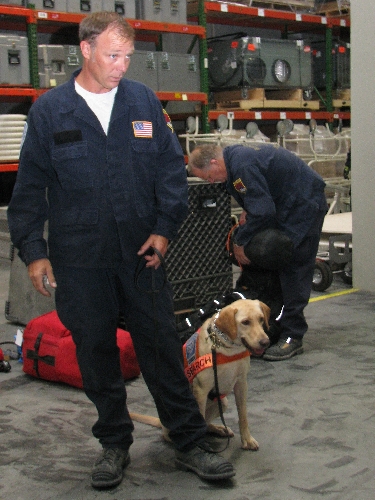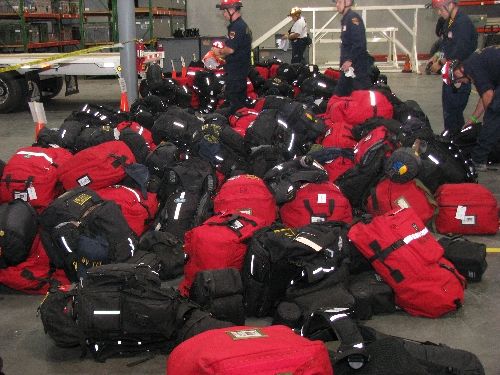Near or far, Nevada Task Force One is ready to respond


When disaster strikes, Nevada Task Force One can be called upon to respond in fewer than six hours.
On July 22, the task force and Nellis Air Force Base conducted a deployment drill to see if they could trim that response time.
"Every hour we’re not there yet translates to less of a chance of survival for someone trapped in a collapsed structure," Paul Bailey, program manager for Task Force One, said on the day of the exercise. "Guidelines say we have to be out in six; we’d like to get that response time closer to four hours."
The task force is one of 28 Federal Emergency Management Agency Urban Search and Rescue teams that are sent to federal disasters to help recover trapped survivors in the critical early hours of an emergency situation. The group includes members of the Metropolitan Police Department, Las Vegas Fire & Rescue and the Clark County, North Las Vegas and Henderson fire departments.
Among the emergencies Task Force One has responded to were hurricanes Gustav and Ike in 2008 and Katrina in 2005, and the World Trade Center in 2001.
When the call goes out, task force members meet at their headquarters on Pecos Road near the intersection of Craig Road. The location is close to Interstate 15 and just down the road from Nellis Air Force Base. For emergencies 1,000 or fewer miles away, they haul their supplies on FEMA flatbed trucks. Beyond that, they rely on the U.S. Air Force to provide transportation by air. The July exercise was designed to test and improve that option.
"We’ve got 80 personnel coming from across the valley," Bailey said. "We’ve got to process and equip them and then move 75,000 pounds of equipment on 16 pallets and get them on the tarmac at Nellis in less than six hours."
The equipment, including food, water, rescue tools and everything the task force needs to be completely self-sufficient for the first three days on the scene, is normally stored on pallets on flatbed trucks in the facility’s warehouse. Weight loads need to be distributed differently for air travel and long transportation by truck, so the pallets can’t simply be kept in airplane configuration on the back of the trucks.
For the July exercise, each pallet had to be unpacked and restacked in a different configuration for air travel. Most notably, the shape of the stack had to be changed to fit into the round body of the plane.
During the exercise, task force members shifted the $5.5 million worth of federally funded equipment in a record amount of time and then boarded personnel onto two buses bound for the air force base.
The task force includes seven dogs trained to search for human survivors. The dogs sniff through rubble and will alert their trainers only when they smell a live person they can’t see. After a second dog confirms this, other task force members then arrive with equipment pinpointing the trapped victim. The dogs train locally, frequently in rubble piles near Nellis.
"It’s fortunate we train here, because we’re not going to go many places that are hotter," John Bernstein of the North Las Vegas Fire Department said.
Bernstein trains and handles 17-month-old Glory, the newest member of the dog team.
"If we’re going somewhere warm or humid, we pre-hydrate them," he said. "If we’re going somewhere cold, the cold doesn’t really bother them much."
The task force carries supplies to sustain the dogs for 72 hours.
"They’re treated just like any member of the team," Bernstein said. "We have their supplies with us. If they get sick, we can provide medicine and start an IV on them. All of the trainers have critical care training for dogs."
At Nellis Air Force Base, the supplies were unloaded with a forklift. The loading was to a staging area posing as an aircraft, as the actual planes that would be used in a real emergency were unavailable at the time of the exercise. Regulations require several of the specific weather-tight boxes to be removed, opened and inspected, such as those carrying large, dry cell batteries.
Passenger Terminal Section Chief Master Sgt. Marcus Reichelt of the 99th Logistics Readiness Squadron said that the time it would take the U.S. Air Force to conduct the required inspections and load the cargo was subject to many variables, but with two aircraft and the experienced packing that Task Force One had already done, the group could be in the air in three to four hours.
"So far, so good," Reichelt said. "We’ll go back afterwards and see where we can do better and where they can do better and we’ll help them out with that."
The task force members filed into a nearby building, dropping their baggage in large wooden crates on the way. The baggage consisted of a pair of large backpacks that are kept at the ready at Task Force One’s headquarters. Each member has six packs at the ready at all times.
In an odd quirk of Federal Aviation Administration regulations, task force members have to pass through Transportation Security Administration security despite the fact that in the event of an emergency deployment, the group, mostly law enforcement personnel and firefighters, are likely to be the only passengers on a military transport plane.
Bailey felt the exercise was a success and found several areas for improvement that could streamline response.
"We had all of our equipment on base in about four hours and 15 minutes," Bailey said. "We got hung up at the gate, in part because we were only assigned one escort, which wouldn’t happen during an actual incident."
Bailey added that the task force would probably try the exercise in about a year and make improvements on the process based on what it learned from this year’s exercise.
"I think we can have those first two tractor trailers on the tarmac in 90 minutes to two hours," Bailey said.
Contact Sunrise and Whitney View reporter F. Andrew Taylor at ataylor@viewnews.com or 380-4532.












